Early Detection Strategies for Autism Spectrum Disorder
This article explores early detection methods for autism spectrum disorder, highlighting screening tools, assessment procedures, and the importance of timely diagnosis. It emphasizes the role of developmental monitoring, behavioral evaluation, and genetic testing in diagnosing ASD early, which is crucial for effective intervention and support. Readers will gain insights into available assessments and the significance of seeking professional help for accurate diagnosis and management of autism spectrum disorder.

Early Detection Strategies for Autism Spectrum Disorder
Autism spectrum disorder (ASD) is a developmental condition that can be influenced by genetics. It impacts communication, behavior, and social interactions. While signs often appear within the first two years of life, the wide range of symptoms makes early detection vital. Since ASD varies greatly among individuals, effective screening is essential for prompt diagnosis and intervention.
Understanding Autism Spectrum Disorder
Infants with ASD typically show no distinct physical features early on, but as they grow, challenges in communication, socialization, and learning become evident. Early recognition is key to providing appropriate support.
Online autism screening tools can offer preliminary insights. These assessments usually consist of up to 50 questions and take only a few minutes to complete. However, they should be viewed as initial indicators only. Professional diagnosis remains indispensable for confirming ASD.
Assessment Methods for Autism
Two main evaluation tools are commonly used:
Repetitive Behavior Questionnaire (RBQ-2)
This 20-item self-report survey targets repetitive behaviors, insistence on routines, and motor routines in adults. It aids professionals in understanding the severity and type of behaviors associated with ASD.
Autism Spectrum Quotient (AQ)
The AQ includes 50 statements with four answer choices to gauge where an individual falls on the autism spectrum. Its moderate accuracy makes it a useful screening instrument.
Beyond initial tests, seeking autism testing centers nearby ensures comprehensive screening. Early detection significantly enhances treatment outcomes and quality of life.
Screening Procedures for Autism
Health experts evaluate developmental history and behavioral patterns to diagnose ASD. Early diagnosis—often by age two—is feasible and beneficial, allowing timely intervention.
Developmental Surveillance
Doctors observe traits such as eye contact and gestures over time, considering family health history, to identify early signs of ASD.
In-Depth Behavioral Assessment
A multidisciplinary team—including psychologists, therapists, neurologists, and physical therapists—reviews the child's behavior to determine if further assessment is needed.
Genetic and Medical Testing
Genetic analyses like chromosomal microarray and whole exome sequencing can reveal chromosomal abnormalities linked to ASD. These tests utilize blood, saliva, or cheek swabs, providing detailed genetic information that supports diagnosis.
Accurate early diagnosis enables better understanding and support for individuals with ASD, fostering improved development and family planning.










